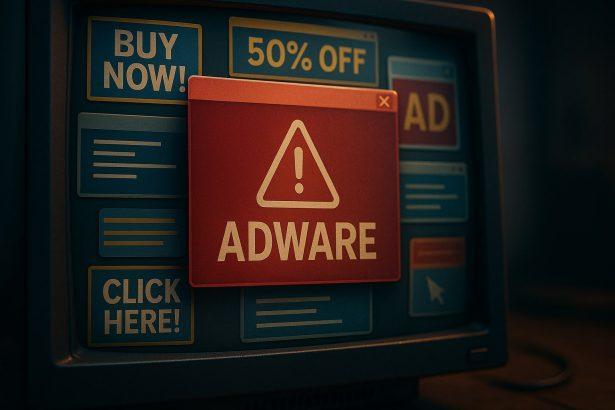Warning: Clicking “Allow” on fake CAPTCHA screens can flood your system with nonstop pop-ups, redirect loops, and potential malware.
These Popups Didn’t Just Appear by Accident
You’re browsing, minding your own business, when a strange page says “Click Allow to verify you’re human.” You do… and suddenly, you’re getting constant notifications—even when your browser’s closed. If you’re seeing spammy ads, fake alerts, or sketchy redirects coming from autblaculfixed.com, you’re not alone. This site is part of a growing wave of malicious push-notification scams, and it can seriously disrupt your browsing or even compromise your security.
Let’s walk through exactly what autblaculfixed.com is, how it hijacked your notifications, and how to remove it completely.
Threat Summary
| Attribute | Details |
|---|---|
| Threat Name | Ads by autblaculfixed.com |
| Threat Type | Push-notification spam, browser-based adware |
| Detection Names | Varies – not always detected by standard antivirus tools |
| Symptoms | Constant pop-ups, fake security alerts, redirects, aggressive ads |
| Damage & Distribution | Can lead to scams, malware installs, or privacy breaches; spread via rogue ads or fake CAPTCHA screens |
| Danger Level | Moderate to high – especially if malicious content is clicked |
How Did I Get Infected With Autblaculfixed.com?
This isn’t your typical virus or malware—it’s a browser-based attack. Most users land on autblaculfixed.com via shady ads, suspicious websites, or redirects from pirated content platforms. The site presents a fake CAPTCHA test, urging you to click “Allow” to proceed. But instead of verifying you’re human, it abuses that permission to bombard your system with intrusive push notifications.
In some cases, adware or a potentially unwanted program (PUP) on your computer may be the reason you’re being constantly redirected to autblaculfixed.com and similar clone domains.
What Autblaculfixed.com Ads Do to Your System
Once you click “Allow,” you’re essentially giving that site permission to send notifications directly to your desktop—even if your browser is closed. These aren’t harmless updates—they’re often packed with:
- Fake virus alerts
- “You’ve won” scams
- Clickbait content
- Redirects to tech support scams, phishing pages, or adult content
- Prompts to download shady software
Even worse, some of these notifications can trick users into downloading real malware, including Trojans, rogue system cleaners, or phishing tools.
Is Autblaculfixed.com Dangerous?
Yes, and here’s why:
While autblaculfixed.com itself is not a virus, the ads and redirects it delivers can absolutely lead to infections. If you click one of these fake notifications, you may be redirected to a site that runs malicious scripts or prompts a download of a Trojan, ransomware loader, or data-stealing app.
Moreover, constant pop-ups slow down browsing, eat up resources, and seriously damage your user experience. In corporate environments, these notifications can even create compliance or privacy risks.
Manual Adware Removal Process (Windows & Mac)
Step 1: Identify and Uninstall Suspicious Applications
For Windows Users
- Open Task Manager by pressing
Ctrl + Shift + Esc. - Navigate to the “Processes” tab and search for unknown or high-resource-consuming processes.
- If you detect anything suspicious, right-click and select “End Task.”
- Go to
Control Panel>Programs>Programs and Features. - Locate and uninstall any unfamiliar programs.
For Mac Users
- Open
Finderand click onApplications. - Identify and move any suspicious applications to the
Trash. - Empty the
Trash. - Check
System Preferences>Users & Groups>Login Itemsfor unknown startup programs and remove them.
Step 2: Remove Malicious Browser Extensions
Google Chrome
- Open Chrome, click
Menu(three dots) >Extensions. - Locate and remove unknown extensions.
- Reset Chrome:
Settings>Reset settings> “Restore settings to their original defaults.”
Mozilla Firefox
- Click
Menu>Add-ons and themes. - Remove suspicious extensions.
- Reset Firefox:
Help>More troubleshooting information> “Refresh Firefox.”
Safari (Mac)
- Open Safari, go to
Preferences>Extensions. - Delete unknown extensions.
- Reset Safari:
History> “Clear History.”
Microsoft Edge
- Click
Menu>Extensions. - Remove any unfamiliar extensions.
- Reset Edge:
Settings>Reset settings> “Restore settings to their default values.”
Step 3: Delete Adware-Associated Files and Folders
For Windows Users
- Press
Win + R, type%AppData%, and press Enter. - Locate and delete suspicious folders.
- Repeat for
%LocalAppData%,%ProgramData%, and%Temp%.
For Mac Users
- Open Finder and press
Shift + Command + G, then enter~/Library/Application Support/. - Remove any suspicious folders.
- Repeat for
~/Library/LaunchAgents/,~/Library/LaunchDaemons/, and~/Library/Preferences/.
Step 4: Flush DNS Cache to Remove Adware Traces
For Windows Users
- Open
Command Promptas Administrator. - Type
ipconfig /flushdnsand press Enter.
For Mac Users
- Open
Terminal. - Enter
sudo killall -HUP mDNSResponderand press Enter.
Step 5: Restart Your System
Perform a reboot to apply the changes and ensure the removal process is complete.
Automatic Adware Removal Using SpyHunter (Windows & Mac)
For an effortless and effective solution, use SpyHunter, a powerful anti-malware tool designed to detect and remove adware completely.
Step 1: Download SpyHunter
Click the link to download SpyHunter: Download SpyHunter Here.
Step 2: Install SpyHunter
Follow the installation guide based on your operating system:
For Windows Users
- Run the downloaded
.exefile. - Follow the installation instructions.
- Launch SpyHunter and allow it to update its malware database.
For Mac Users
- Open the downloaded
.dmgfile. - Drag and drop SpyHunter into
Applications. - Open SpyHunter and let it update its database.
Step 3: Scan and Remove Adware
- Open SpyHunter.
- Click
Start Scan. - Wait for the scan to complete.
- Click
Fix Threatsto remove detected malware.
Step 4: Restart Your Computer
After SpyHunter removes all threats, restart your system to ensure all adware components are fully removed.
Conclusion
Autblaculfixed.com is part of a fast-growing ecosystem of scammy, ad-spamming websites that exploit browser permissions. If you’ve allowed notifications from it—or from similar domains—take action now. Revoke the permissions, scan your system for adware, and tighten your browser’s privacy settings.
Avoid clicking “Allow” on any site unless you fully trust it, and be cautious around pop-ups that urge you to take immediate action. Prevention is easier than cleanup—but with the steps above, you can eliminate autblaculfixed.com for good.




